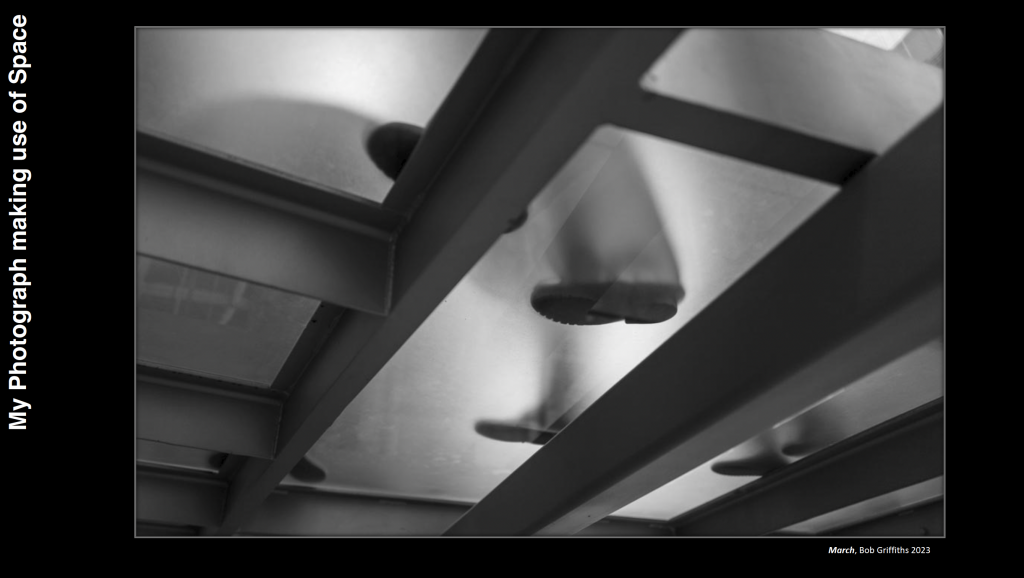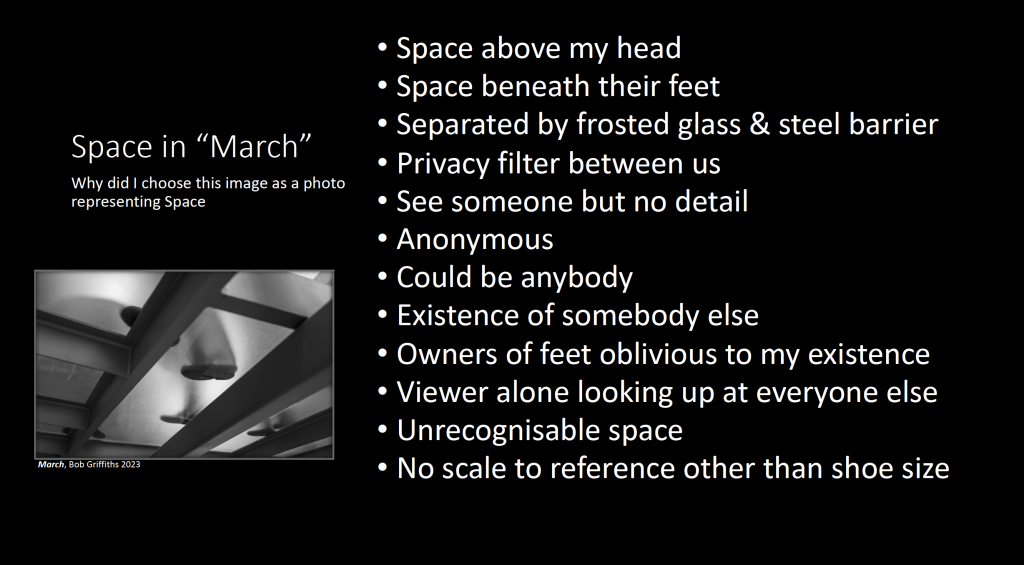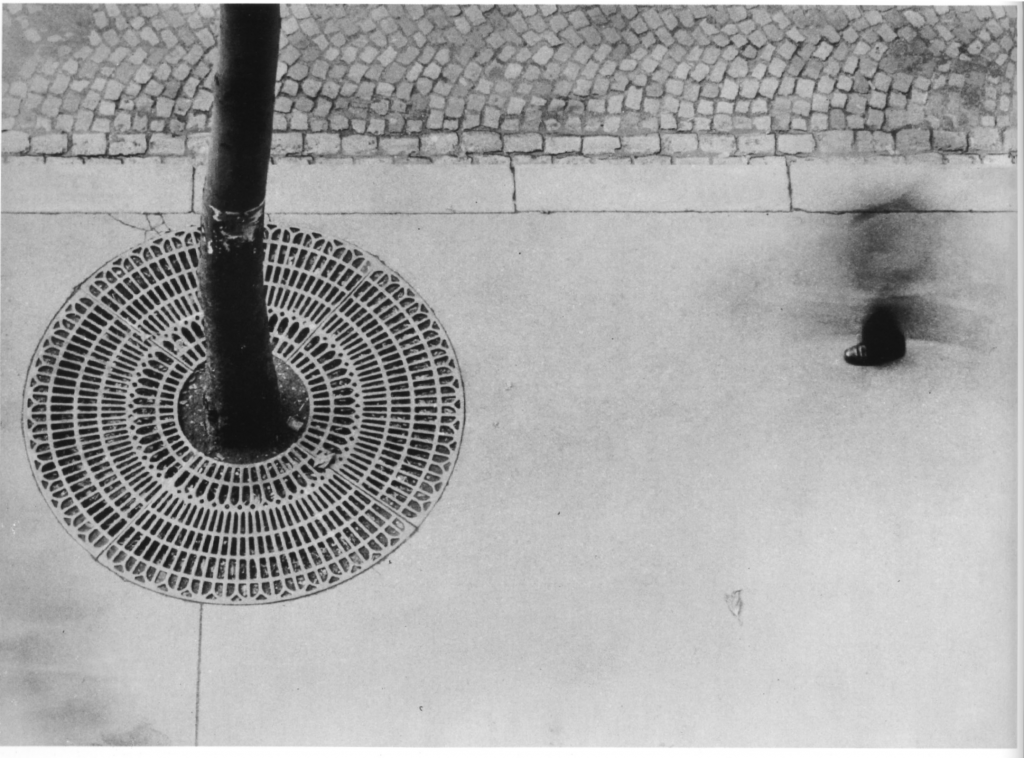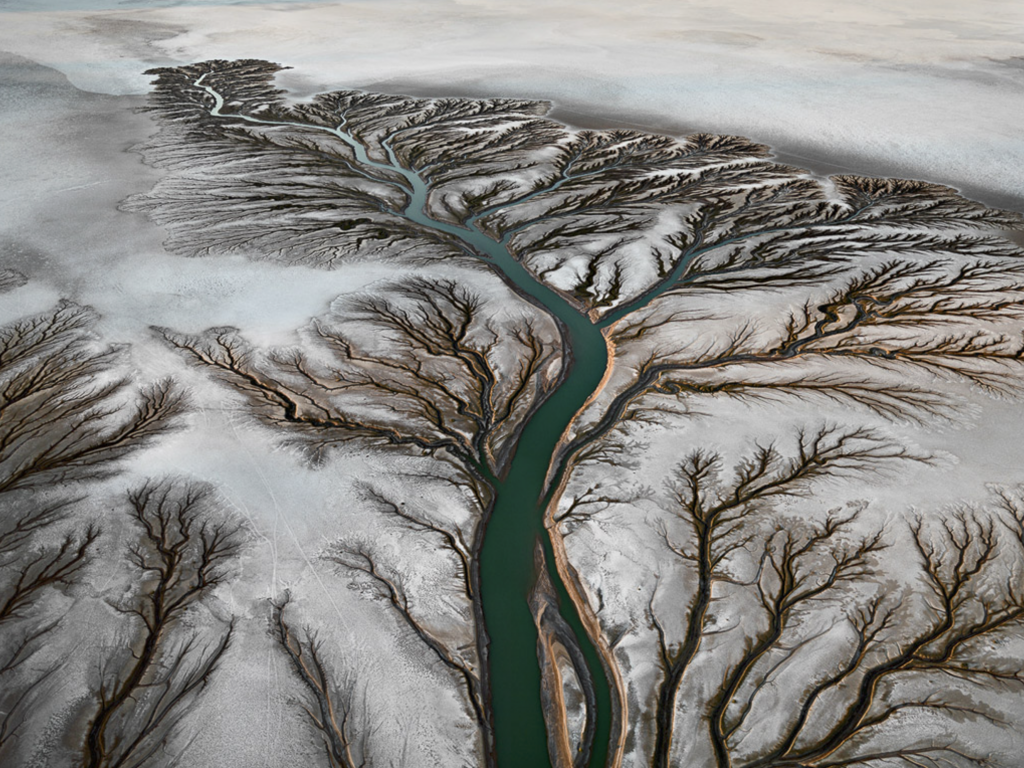In week 10, Sylvia gave us a task to think about how “space” is represented in photographs.
Think about Massey’s ideas around space and in particular the questions:
- How can we open up our spatial imaginations?
- How can we explore the multiplicities and complexities of space?
We need to create a 5 minute presentation for next Tuesday. Your presentation should include the following:
1. Select one of your own photographs and talk about how you have explored the idea of ‘space’ with it.
2. Select one image from a contemporary photographer and talk about how you think they have explored ‘space’ through the photograph.
For the first part of the task I’ve selected one of my photographs, a recent image made in the IKON Gallery in Birmingham on our previous school of art trip. March shows the feet of at least four people walking above me on the floor above, which happens to be a frosted and tempered glass. I listened to previous critique and included a large size image in the slide to allow the viewers of the presentation to see the small details.

Then we had to consider how I have explored the idea of “space” in the photograph so I came up with this bullet point list.

You’ll see that the viewer and the owners of the feet above are separated and therefore in different spaces. If a person looked in through the window though, they would be in a different space to me and the feet owners. It sounds like a nested structure: room / floor / building / street / city /region / country / continent / planet / galaxy / universe. Where do spaces start and stop? I suppose it depends where you are and what you can see or experience.
The second part of the presentation was to pick a contemporary photographer and examine how they have used “space”. For my choice I selected Masataka Nakano and his photo Shinjuku Shinjuku-ku , 2000, from his amazing book Tokyo Nobody.

As you can see it is a photograph of a part of Shinjuku city in Tokyo, Japan. The whole book this image belongs to features no people in it, and where this scene would usually be busy, Nakano has found a time of day when there is no-one to get in the way. I originally thought that he may have used long exposure and ND filters to allow people to move photos without being seen, but no.
My list of bullet points can be seen below which features my thoughts as to how “Space” is used in the photo or the process of making the image.

It was an interesting exercise to think about how space is represented in images and also films. The Nakano photo is reminiscent of Nadav Kander’s images that we looked at last week, with the muted colour palette looking similar to de Miranda’s derelict buildings.
My own photo above doesn’t have much space in it. It’s quite a claustrophobic shot where Nakano’s is wide open space. They both represent space in their own ways though and that’s what is subjective about the whole subject of art and photography. I read a photograph one way, where you might read it a completely different way.
Let’s see how we get on with the presentation tomorrow shall we, I’ll update the blog with a new post, once I’ve had some feedback and seen the other coursemates work.
EDIT: For the presentation we had to wait for an extra week as Sylvia was unfortuantely off ill.
We all got together on the last day before Christmas with some snacks, in the lecture theatre and sat to watch each other’s information on the response to the task mentioned above.
Emma was up first and discussed Andrew Brown , Moi Ver and Otto Steinert before discussing one of her own photos. the photo of Steinert’s A Pedestrian In Paris, 1951 where we see an aerial view of a Paris street. We discussed this image in a seminar back in September 2022 in terms of “Time” when discussing The Photographer’s Eye by John Szarkowski

Ieva spoke about the photos of Yves Merchand and Romain Meffre and one of their old buildings that they’d captured an image of, which when compared to Ieva’s photo of a church back in Lithuania shows us the use of space in both photos.
Up next was Shellie who shared a photo I’d not seen before, 99 Cent, by Andreas Gursky who took a photo of a row of shelves in a 99 cent store in the U.S. It shows us the use of most space in the image being full of consumables waiting for their purchase. She contrasted this with a photo of her own called Peace which showed the underside of a pier in Australia going out to the sea in which there is very little movement of the water. This is similar to the two photos Ieva showed us in the vanishing point effect was comparable.
Beth was then stood at the front and showed us a photo by Edward Burtynsky called Colorado River Delta #2. A stunning image of the delta of the river seeming to break through in a tree like fashion the ice of the sea in which it’s flowing into. This pattern shows like branches on a tree or even like those patterns burnt into wooden table tops by using high voltage. (Lichtenberg Burnings) It’s a great use of space for the photo must ave been taken from an aerial position but the scale of it means it could be any size at all.

Noah was the penultimate presenter and showed us images by Felix Hernandez in a series called Playing in the House in which the photographer was using miniature cars, or toys to make realistic looking photographs. Noah was taken by a VW Bus Pickup with toilet rolls on it’s pickup bed, and the painted sign on the door said “Virus Busters”. It was a satire on the rush to buy toilet rolls at the time the photo was made in the Covid Pandemic Lockdown and showed how the scale was used to make the inner space of Hernandez’s house seem like another world. Noah countered this with one of his own images showing the concrete structure atop the carpark in a nearby town centre.
I was last to talk about my slide deck and I had a couple of nice comments about my image and some amazement that Nakano’s image had zero people in it, considering it’s location in the city of Tokyo. I’m going to have to revisit this location when I get there in a couple of weeks time to see just how busy it really is.
It was a good session and worth seeing what other people thought of the word Space and how it fitted into the photos that they had picked to share with the group. Sylvia was happy that we’d all engaged with the task and then said we could all disappear off to head home ready for the Christmas break, little did she know I still had a couple of days of work in my full time job left before I could put my feet up.
Be First to Comment